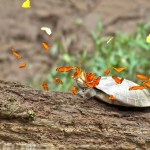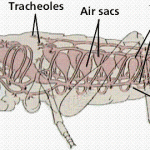turtle
It must be Friday. I found myself perusing YouTube videos and I came across these showing pet tortoises that have figured out how to solve some interesting problems such as:
Using the doggie door to enter a house...
If that does not work, many have figured out how to just open the back door...
Some have even figured out how to open the refrigerator...
After watching these videos, I naturally went in pursuit of any information I could find as to whether tortoise intelligence has been tested scientifically. In support of many pet owner claims, tortoises do exhibit signs of…
Check out this neat video from National Geographic's emerging explorer, David Gruber (a marine biologist at the City University of New York) in which he discusses coming across what he claims is the first observation of biofluorescence in a sea turtle:
Video source:
YouTube
Photo of a red-eared slider turtle by Nightryder84.
Dr. Thane Wibbels (University of Alabama at Birmingham) is interested in studying how temperature affects the sex of red-eared slider turtle embryos. For humans, the answer is simple: sex chromosomes. You know, the combination of XX means girl and XY means boy.
Turtles are not that simple. Temperature is a factor in determining whether the embryo will be male or female. If the eggs are incubated at 78.8 degrees F, the hatchlings will all be male. If they are incubated at 87.8 degrees, they will all be female. As I'm sure you've guessed,…
With the help of advice from a manicurist, Dr. Kate Mansfeld (University of Central Florida) has come up with a way to track hatchling sea turtles for the first time. After hatching, the turtles head straight for the ocean where they grow for about 10 years or so before returning to the same beach where they hatched. Until now, researchers have wondered how these juvenile turtles spent their time.
Source:
Scientific American
Amazonian butterflies drinking turtle tears.Image from: Jeff Cremer / Perunature.com
The Amazon region is notoriously deficient in sodium because of its large distance from the ocean and because the Andes mountains block the delivery of windblown minerals from the West. Some minerals travel from the east, but much of the air is cleaned by rain before the minerals can make it to the western region of the Amazon Basin.
So if you were a butterfly, where would you find a readily available source of salt in the Amazon? The answer is not very obvious, unless you look at the photo of a yellow-…
"I don't understand how super mario can smash blocks with his head but dies when he touches a turtle." -Unknown
The past few weekends have been far too serious around the internet, and it's time to kick back and enjoy something nice and simple. I'd like to introduce you to the little-known indie band The Mountain Goats, who, along with Kaki King, sing a delightful song about feeling trapped and being rescued, called
Thank You Mario But Our Princess Is In Another Castle.
Of course, those of you who remember your old nintendo cartridges will know exactly where the song title comes from.
Image…
Today's symposia included a session on "Integrative Cardiovascular and Respiratory Physiology of Non-model Organisms" as well as the August Krogh Distinguished Lecture.
This year's Krogh lecture was given by Dr. Stan Lindstedt from Northern Arizona University. Dr. Lindstedt is arguably best known for publishing work showing that the metabolic rate of an animal is negatively correlated with body mass. In other words, smaller animals have a higher metabolic rate than larger animals. Knowing that relationship could have saved Tusko the elephant from a whopping dose of LSD (1962, prior to the…
Another exciting day for Comparative Physiology! I just got back to my hotel after the wonderful dinner meeting overlooking the Harbor.
Of course, the research was exciting too :)
Here are the highlights from today's sessions:
Heinrich E, Bradley T. Univ California, Irvine I learned a lot about the insect tracheal system this morning. Insects do not have continuous gas exchange with environment like we do. Rather, gas exchange is discontinuous and involves valves, called spiracles:
Diagram of how insects breathe from www.breatheornot.wordpress.com
When carbon dioxide levels increase…
The last known member of the subspecies Pinta Island tortoise (Chelonoidis nigra abingdoni), affectionately named Lonesome George, passed away on Sunday at about 100 years old (no one knew his exact age). He had been the last of his kind in the Galapagos Islands for the past 40 years, earning his nickname. The suspected cause of death is a heart attack. The Galapagos National Park Service will be preserving his body for future studies.
The reason for the extinction of these tortoises: overhunting by fishermen and sailors in the 19th century along with habitat destruction by feral…
New YouTube research definitively proves that turtle society is highly altruistic and that Disney's heretofore refusal to make a movie about them is racism, pure and simple.
She: "What are you writing about?"
Me: "Cognition in cold-blooded animals."
She: "Hot."
Most people who study cognition focus on mammals or birds. But I hope I've convinced you that other animals are important to investigate as well. One research group at the University of Vienna likes cold-blooded critters. Turtles and lizards and such. They argue:
Reptiles, birds and mammals have all evolved from a common amniotic ancestor, and as such they are likely to share both behavioural and morphological traits. However, this common ancestor lived around 280 million years ago and so it is equally…
Close up of one of the Pipe Creek Sinkhole coprolites showing structures interpreted as hair (A) and a close-up of a mold in the coprolite thought to have been made by a hair (B). From Farlow et al, 2010.
Time and again I have stressed that every fossil bone tells a story, and, in a different way, so do coprolites. They are small snapshots of a moment in the life of an organism, often preserving bits of their meals, and while they may not get top billing in museum halls, they are among the most pungent reminders that weird and wonderful organisms really did live during the remote past. As…
So a week back or so, a number of friends read an article about death by rectal eel and immediately thought of me. For those of you who missed the story, it went a little something like this:
* Chinese man gets drunk with friends and passes out
* Friends think it would be hilarious to insert a large living swamp eel into the man's butt while he is unconscious
* Hilarity does not ensue. In fact, the man dies. Chinese doctor says the eel "consumed the man's bowels"
The article was widely reported in major news outlets like CNN and the Times, but I am linking instead to the UK edition of…
An eastern painted turtle (Chrysemys picta), photographed in suburban New Jersey.
An eastern painted turtle (Chrysemys picta), photographed in suburban New Jersey.
An eastern painted turtle (Chrysemys picta), photographed in suburban New Jersey.
The turtle's shell provides it with a formidable defence and one that is unique in the animal world. No other animal has a structure quite like it, and the bizarre nature of the turtle's anatomy also applies to the skeleton and muscles lying inside its bony armour.
The shell itself is made from broadened and flattened ribs, fused to parts of the turtle's backbone (so that unlike in cartoons, you couldn't pull a turtle out of its shell). The shoulder blades sit underneath this bony case, effectively lying within the turtle's ribcage. In all other back-boned animals, whose shoulder blades sit…
Clad in hard, armoured shells, turtles have a unique body plan unlike that of any other animal. Their shells have clearly served them well and the basic structure has gone largely unchanged since the time of the dinosaurs. But this unchanging nature poses a problem for anyone trying to understand how they evolved and until now, fossil turtles haven't provided any clues. All of them, just like their living descendants, have fully formed two-part shells.
But three stunning new fossils are very different. They belong to the oldest turtle ever discovered, which lived about 220 million years ago…
tags: Painted Turtle, Red-eared Slider, reptile, Image of the Day
"Very good but try harder to get your other leg off the ground and don't forget to breathe and don't strain."
Image: Bob Levy, author of Club George. [Wallpaper size]
The photographer writes: For a change here's something I can recommend you try at home. I serendipitously stumbled into a turtle-yoga class. Not being an expert I found it hard to interpret the significance of this one-on-one situation involving members of two different species. The smaller one looks like a Painted Turtle and the other a Red-eared Slider. Can…



